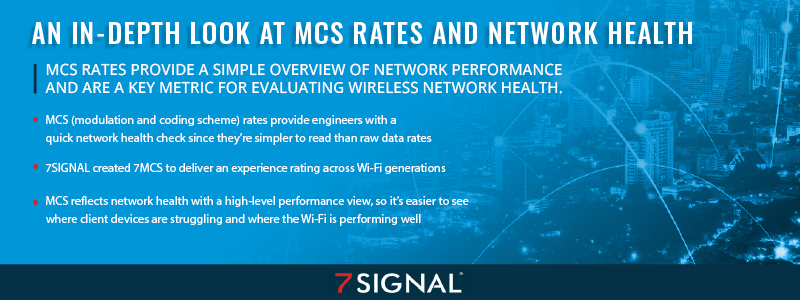
Blog
MCS rates provide a simple overview of network performance and are a key metric for evaluating wireless network health.

The health of your Wi-Fi network significantly impacts the variety of stakeholders that enter and exit your premises each day. Guests and clients want the ability to connect to Wi-Fi from their mobile devices, and staff members depend on a reliable connection to transfer data, communicate, and get work done efficiently. Measuring the network’s health consistently is thus critical to managing successful Wi-Fi.
One important measure of network health is the MCS index, which provides a rate that gives engineers a good indication of how a user is experiencing the wireless network. This guide walks through why MCS is important, how 7MCS is different, and how MCS can be more reflective of network health than the raw data rate.
What are MCS rates?
MCS stands for modulation and coding scheme, an index that measures certain Wi-Fi connection parameters that exist between a wireless access point (AP) and a client device. MCS shows the type of modulation and coding rate for spatial streams, guard intervals, and channel widths.
MCS rates simplify data rates so we can understand them in a general overview. MCS encapsulates each moving part, from signal strength to interference to the propagation environment. It is like a one-stop shop for connection quality.
Looking at MCS rates doesn’t provide a complete view of everything involved in the network, but it’s a nice, quick health check. For instance, Mobile Eye® and Sapphire Eye® from 7SIGNAL collect hundreds of measurements and retry rates on the APs, all in addition to MCS rates. But MCS is a good starting point for assessing network health since it condenses a great deal of data.
How is 7MCS different from MCS?
7SIGNAL created a similar measurement called 7MCS since Windows doesn’t reveal MCS. 7MCS can show the MCS value for Windows 10 and Macs on a scale from 0 to 11.
In addition, 7MCS is required because it adjusts the MCS values from 802.11n, making them unspecific to a spatial stream number. You can actually look and compare 7MCS rates across all Wi-Fi generations.
7MCS only considers the modulation and coding rate of the frame, like 802.11ac and 802.11ax, so for those Wi-Fi generations, MCS is equal to 7MCS. However, 802.11n takes into account the number of spatial streams, so it runs on a bit of a different scale. We can then map 802.11n MCS rates on the same scale that 802.11ac and 802.11ax use with 7MCS.
In short, 7MCS is valuable because it provides the experience rating across any PHY or operating system.
How MCS rates reflect network health
Network health can be evaluated by many metrics. Examples include packet loss, latency, uptime, jitter, throughput, bandwidth, signal strength, and more.
But assessing data rates on their own, which look at spatial stream numbers, the channel, and the throughput, don’t always correlate with or reflect the actual connection quality. It can be much more difficult to look at the raw data and get a high-level view of performance.
7SIGNAL’s Mobile Eye® sensor tracks download rates, and it’s helpful to collapse those rates into 7MCS rates instead of the raw data rates. It’s much easier to see where clients are having a hard time versus where the network is performing well when performance is summarized as MCS rates.
Let’s look at a hypothetical example from a large commercial campus where 7SIGNAL’s sensors conduct four or five tests in an hour. The throughput reading shows that the worst test done over the course of an hour sees 400 to 250 Mbps for the high-performing APs, while the slower APs show 250 to 100 Mbps in the worst test within the hour. These don’t indicate that anything is performing too terribly within the network, per se, even though it could be a little better.
Next, let’s look at signal strength. The fast APs show an average signal strength of –15 to –63 dBm, so that’s pretty good performance. The slower APs show –53 to –63 dBm for average signal strength, which means that the APs are still performing quite well.
But then, look at the MCS rates. The fast APs saw rates in the sevens, eights, and nines, with a few fives and sixes. The slower APs, with almost the same signal strength, read primarily in the fours, fives, and sixes, with very few eights and nines. This indicates a more significant performance problem.
So, the MCS rates more clearly represent the relative performance of those APs. Speed or signal strength on their own may not be reflective of network health in every case.
Should MCS be used on site surveys?
Because of the benefits of looking at MCS rates, you may wonder if it should be the measure of choice for site surveys. So, instead of a site survey that wants to see –65 or –68 dBm everywhere in a network, maybe the goal is to have MCS rates at seven or better everywhere. Theoretically speaking, this would be a big plus.
However, the issue is that measuring signal strength is relatively consistent, even though it may have a lot of issues. MCS rates are so affected by things like interference that it’s harder to be consistent on those rates.
For example, if a neighbor installs a wireless network, it could significantly impact your MCS rates but not your signal strength. So, it’s not as practical. It’s better to stick with signal strength for site surveys.
Why 7SIGNAL uses MCS rates to measure the Wi-Fi experience
Looking at MCS rates can give you much important information about network health in a simplified, quick manner. 7SIGNAL recognizes how informative and helpful this metric is when looking at how end users are experiencing the Wi-Fi network at a given moment.
One of the problems Mobile Eye® detects is radio frequency (RF). It will send the RF error when you see good signal strength and no other interference but poor MCS values. The Eye knows there’s some other RF problem other than adjacent or co-channel interference that can be pulled out separately.
Learn more about 7SIGNAL, Mobile Eye®, and Sapphire Eye®. Contact our team today.
7SIGNAL is the leader in wireless experience monitoring, providing insight into wireless networks and control over Wi-Fi performance so businesses and organizations can thrive. Our cloud-based wireless network monitoring platform continually tests and measures Wi-Fi performance at the edges of the network, enabling fast solutions to digital experience issues and stronger connections for mission-critical users, devices, and applications. Learn more at www.7signal.com.